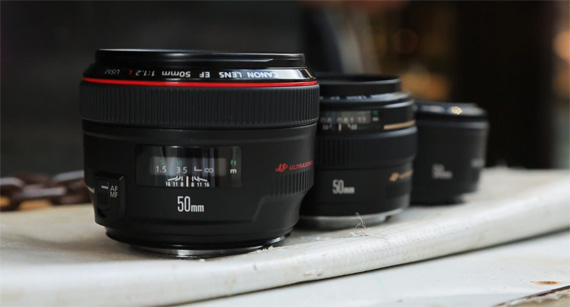Deciding which 50mm prime lens to buy can be daunting, considering the many different brands, apertures, and prices. Even after a photographer has chosen a company to buy from, it can be difficult to narrow the options to just one lens. Fortunately, Kai hopes to clear up some of that confusion through its in-depth review of Canon’s three 50mm prime lenses—the f/1.2 L, f/1.4 USM, and f/1.8 II— discussing the key factors to consider to find the right lens for you:
Kai, DigitalRev TV’s iconic narrator, reviews the Canon f/1.2 L, f/1.4 USM, and f/1.8 II on the basis of budget, ergonomics, and usability. “Sometimes it’s the little things that matter the most,” he said.
At an estimated price of $125, the 1.8 is Canon’s cheapest 50mm option, but don’t underestimate the lens because of “the overenthusiastic use of plastic in the build,” Kai advised. Not only can this little lens compete in quality with its more expensive counterparts, it also hardly adds weight to your camera setup, making it the choice 50mm lens for long photo treks. One major drawback for this little lens is speed—in good lighting, you’ll hardly notice the different between the 1.8 and the 1.4 or even the 1.2, but in low-light conditions, the 1.4 and 1.2 will excel where the 1.8 cannot.
The 1.4 lens costs around $400, which is expensive, but not too costly if you’re a careful saver. Canon improved the build on the 1.4, using denser plastic and constructing the lens more solidly, Kai explained. Even better, he said, you get “extra speed in terms of aperture—and when we’re talking about Canon, you get ultrasonic motor.” While not quite as fast as the 1.2, the 1.4 is a sturdy, high-quality alternative, producing decent bokeh and enabling photographers to shoot with very shallow depth of field.
The benefits of the 1.2 lens are obvious; with its ultrasonic motor, the 1.2 produces better quality images, excellent bokeh, and very shallow depth of field when compared to the 1.4 and 1.8—but its drawbacks are just as dramatic. You’ll pay a premium for the 1.2, an estimated $1,620, and it’s heavy—really heavy. At 600 grams (1.3 pounds), the 1.2 weighs as much as Canon’s 700D camera. “Is there really any real need to carry another camera body on the front of your camera body?” Kai wondered, and also warned consumers that the 1.2 is not entirely consistent; despite its f-speed, it sometimes has trouble focusing and, under certain conditions, its bokeh ranks beneath the 1.8.
In the end, DigitalRev TV advises photographers to conduct their own research to find the 50mm lens that best suits their specific needs, and to remember that the photographer produces images, not the equipment.
“Don’t be too caught up thinking about what lens produces the best images,” Kai said. “You’re the one who takes photos, not that bit of glass in front of your camera. Think about what kind of photo you want to create and simply buy a lens that works best for you.”
Like This Article?
Don't Miss The Next One!
Join over 100,000 photographers of all experience levels who receive our free photography tips and articles to stay current:











I have owned all three 50mm lenses and I was not satisfied with any of them because of noisy/slow 1.8, serious CA’s for the 1.4 and focus shift on the 1.2L.
I was going to buy the Sigma 50A but the new 50mm STM came and it’s now my back-up lens since it’s ultra light and compact, very sharp and accurate AF and offers low CA and just for few $$$.
Obviously the Sigma 50A is way better but it costs 7x times, it’s bigger and weights 5x more.
Be careful with the 1.4 – travelling/storage with the lens extended (I.e. not at the limit of focus) can damage the lens if pressure is applied. Best advice is to keep a hood permanently attached to the body of the lens.
Why does Canon bother to put on the market expensive lenses that are worse in almost every aspect than cheaper alternatives they produce. Is half a stop really worth a heavy, inaccurate lens that costs over 4x the next model down the road. I do know about dimnishing returns, but normally more expensive stuff is better (at least slightly).
nice comparison